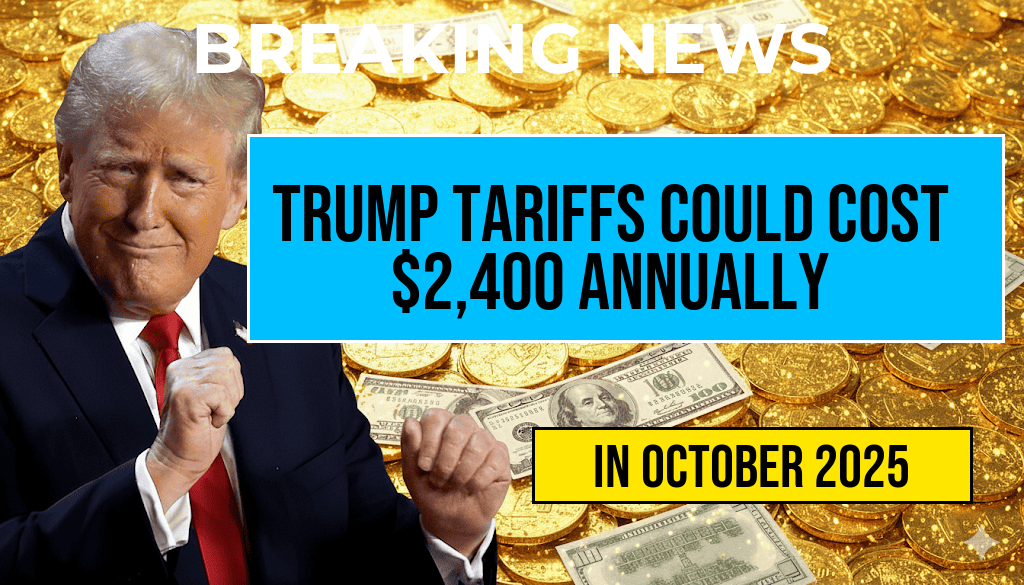Recent analyses suggest that the tariffs implemented during the Trump administration could be costing American families an average of $2,400 annually. Dubbed the “Turbulence Tax” by some economists, these tariffs have increased prices on a broad range of imported goods, from electronics to everyday household items. While initially justified as a measure to bolster domestic manufacturing and address trade imbalances, critics argue that the economic fallout disproportionately impacts consumers, especially those with limited income. Understanding the scope of these costs involves examining how tariffs influence supply chains, retail prices, and household budgets. As policymakers debate future trade strategies, families are feeling the tangible effects of these tariffs in their monthly expenses, prompting questions about the actual benefits versus the economic strain they impose.
Understanding the Impact of Trump-era Tariffs on Household Expenses
The tariffs introduced during President Donald Trump’s tenure targeted various countries, notably China, Mexico, and the European Union, aiming to rebalance trade deficits and protect American industries. However, these tariffs often function as taxes levied on imported goods, which are generally passed down to consumers. A comprehensive report by the U.S. Census Bureau indicates that increased costs in imported products have ripple effects throughout retail sectors, leading to higher consumer prices.
How Tariffs Translate into Higher Costs
- Increased Product Prices: Tariffs raise the cost of imported goods, which retailers often pass on to consumers. Electronics, furniture, and clothing saw notable price hikes during the tariff period.
- Supply Chain Disruptions: Tariffs caused delays and increased costs in supply chains, resulting in shortages and further price inflation.
- Reduced Competition: Higher tariffs can limit imports, decreasing market competition and allowing domestic producers to raise prices.
Estimating the Family Cost: The “$2,400” Figure
Economists have calculated that the average American family spends approximately $400 to $500 annually on goods directly affected by tariffs. When factoring in increased prices across the retail spectrum—such as electronics, apparel, and household goods—the cumulative cost can reach up to $2,400 per year. This estimate considers both direct increases in purchase prices and indirect effects like higher shipping costs, which influence broader economic activity.
The Broader Economic Effects of the “Turbulence Tax”
Consumer Spending and Savings
Higher prices diminish disposable income, leading many families to cut back on discretionary spending. A report from Forbes notes that reduced consumer spending can slow economic growth, creating a cycle where increased tariffs lead to decreased household financial stability.
Impact on Employment and Wages
While tariffs aim to protect domestic jobs, some sectors have experienced layoffs or wage stagnation due to increased production costs and retaliatory trade measures. Small businesses, in particular, often feel the pinch as they struggle to absorb higher input costs without raising prices beyond what consumers are willing to pay.
International Retaliation and Trade Tensions
Tariffs frequently prompted retaliatory actions from trade partners, leading to a series of trade disputes that further destabilized global markets. These tensions can indirectly affect American families through broader economic uncertainty and fluctuating prices in global commodities.
Consumer Strategies to Mitigate Tariff-Related Costs
Families seeking to offset the “Turbulence Tax” may consider several approaches:
- Prioritize Domestic Products: Investing in locally produced goods to avoid tariffs on imports.
- Shop Smart: Comparing prices across retailers and timing purchases around sales events.
- Reduce Non-Essential Spending: Limiting discretionary expenses to accommodate higher essential costs.
- Support Policy Changes: Engaging with policymakers to advocate for trade policies that balance economic growth with consumer protection.
Looking Ahead: Policy Debates and Consumer Outcomes
The ongoing debate over tariffs centers on balancing national economic interests with consumer welfare. Some experts argue that tariffs could be strategically used to negotiate better trade deals or protect key industries, while others warn of long-term economic damage to households. The Biden administration has signaled a shift toward more targeted trade policies, but the effects of prior tariffs continue to ripple through American households.
| Cost Component | Estimated Impact |
|---|---|
| Direct tariff pass-through | $400 – $500 |
| Supply chain disruptions | $800 – $1,000 |
| Market and price inflation | $1,000 – $1,400 |
| Total Estimated Cost | $2,400 |
As families continue to navigate these costs, transparency and effective policy decisions will be pivotal in minimizing the financial strain. Consumers and lawmakers alike are watching how trade policies evolve, knowing that the economic ripple effects influence household budgets more directly than often acknowledged.
Frequently Asked Questions
What is the “Turbulence Tax” and how does it affect families?
The “Turbulence Tax” refers to the increased costs resulting from Trump tariffs on imported goods, which may cost the average family up to $2,400 annually. These tariffs can lead to higher prices on products like electronics, clothing, and appliances, ultimately impacting household budgets.
How do tariffs increase the cost of everyday products?
Tariffs impose additional taxes on imported goods, which manufacturers and retailers often pass on to consumers. This results in higher retail prices for everyday items, making it more expensive for families to purchase necessary products.
Which products are most affected by the Trump tariffs?
Products such as electronics, clothing, automobiles, and household appliances are significantly impacted by tariffs. These goods often have higher import taxes, leading to increased prices that families pay at the checkout.
What can families do to mitigate the impact of these tariffs?
Families can consider shopping smarter by comparing prices, seeking out domestic alternatives, and prioritizing essential purchases. Staying informed about tariff updates can also help in making cost-effective decisions.
Will the tariffs’s impact on prices last forever?
The duration and extent of the impact depend on government policies and trade negotiations. Changes in tariffs could either increase or decrease the additional costs, so families should stay updated on policy developments that may affect prices.





